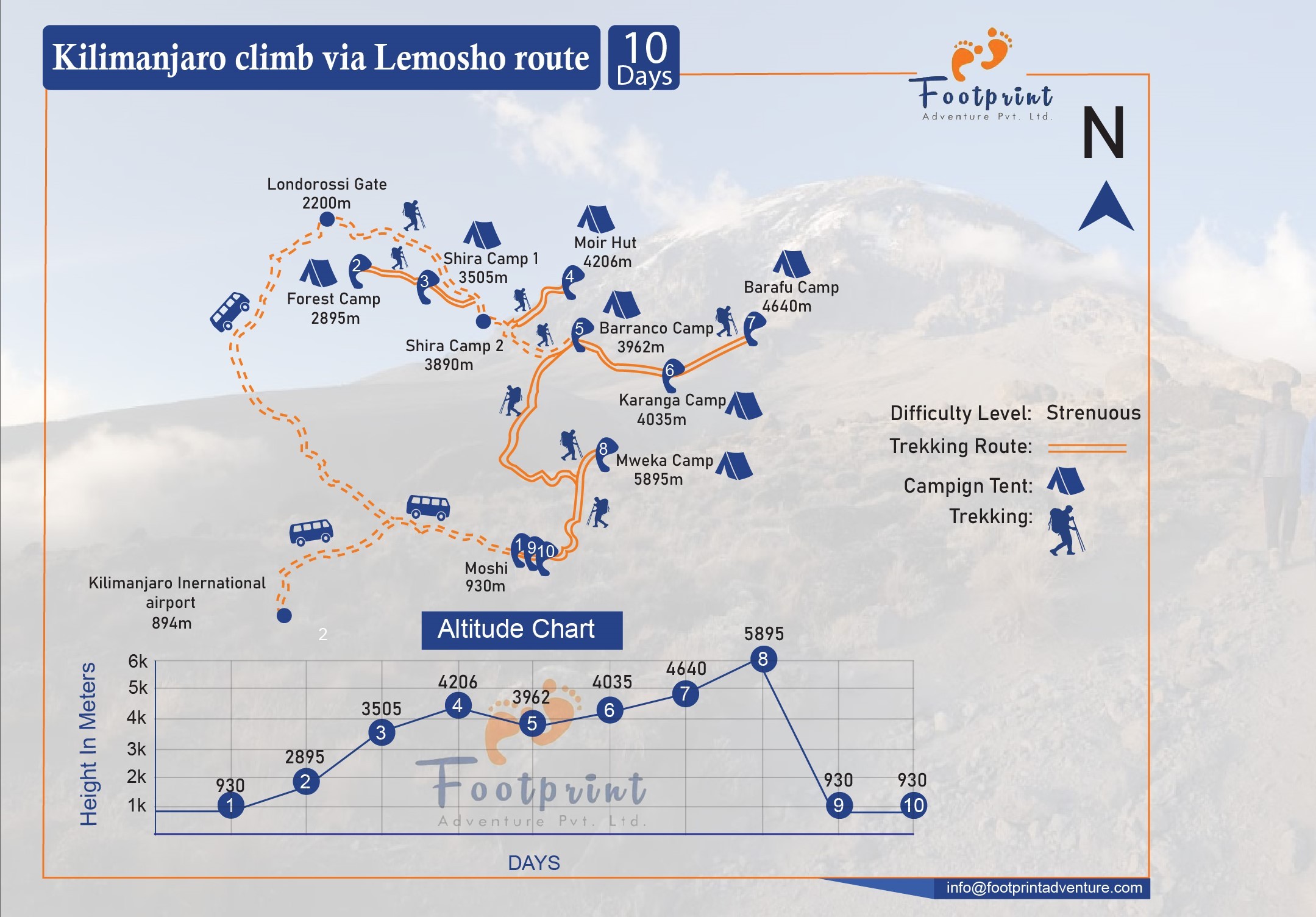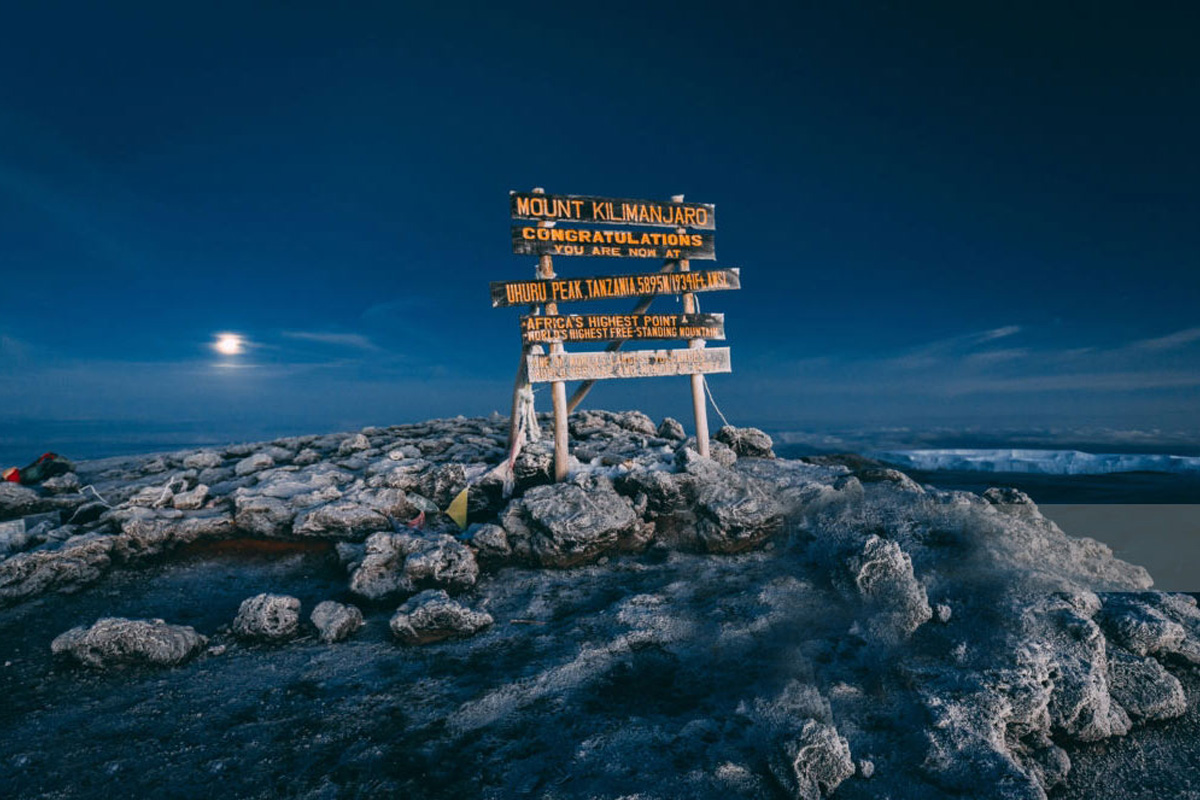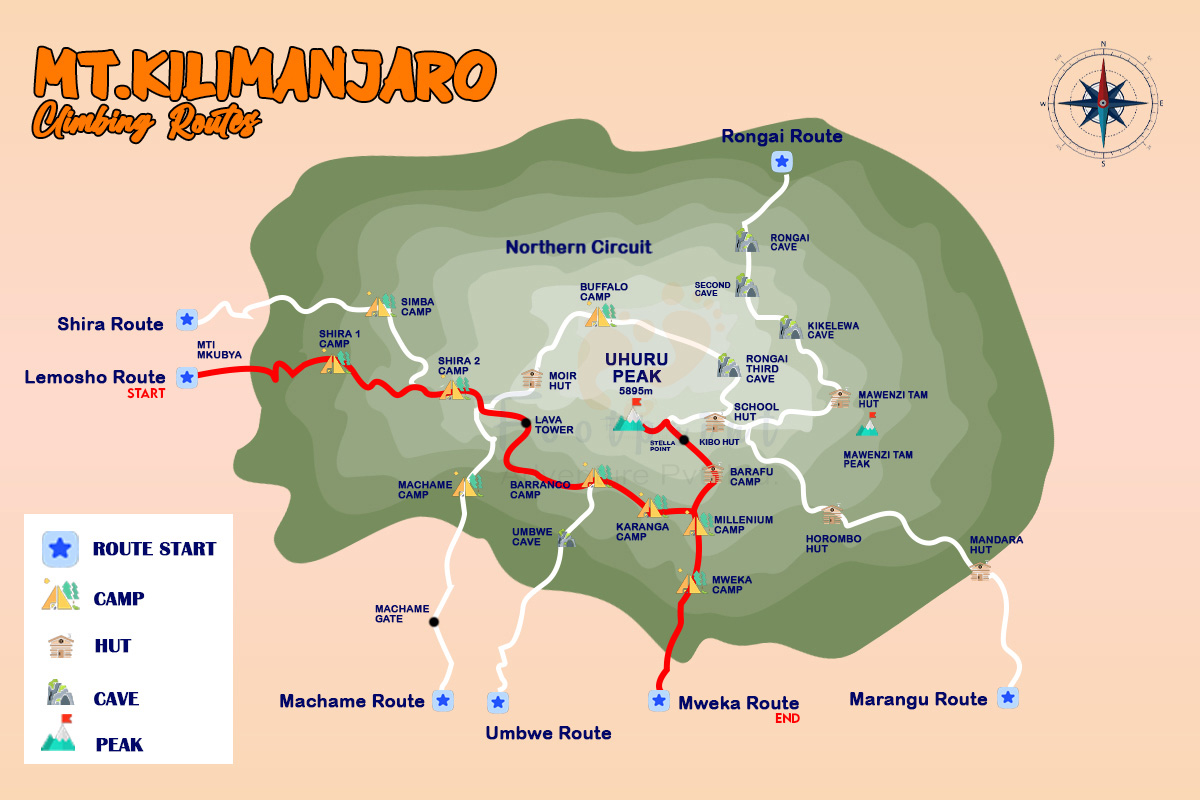Why Choose the Lemosho Route?
If you're considering climbing Kilimanjaro, you've likely come across the various trekking routes—each with its own unique features. Here's why the Lemosho Route is a standout choice:
- Spectacular Scenery: The Lemosho Route takes you through a variety of breathtaking landscapes, from lush rainforests and moorlands to alpine deserts and glacier-covered peaks. Every day offers something new to marvel at.
- Optimal Acclimatization: With an extended itinerary of 8–9 days, the Lemosho Route gives your body more time to adjust to the altitude, significantly improving your chances of reaching the summit safely.
- Fewer Crowds: Starting on the western side of Kilimanjaro, the Lemosho Route is one of the less crowded options, especially in the early stages, offering a more peaceful trekking experience.
- Abundant Wildlife: The journey begins in the pristine rainforest, home to animals like colobus monkeys, elephants, and buffalo, adding a touch of safari magic to your trek.
- Flexible Options: The Lemosho Route can be extended or modified to suit your preferences, making it an excellent choice for both beginners and experienced climbers.
A Detailed Look at the Kilimanjaro Lemosho Route Map
The Lemosho Route begins at Londorossi Gate, situated on the western side of Mount Kilimanjaro. Over the course of the trek, you'll journey through diverse ecosystems, crossing the Shira Plateau, tackling the challenging Barranco Wall, and ultimately reaching Uhuru Peak, the highest point in Africa at 5,895 meters (19,341 feet).
Everything You Need to Know About Lemosho Route: A Complete Guidebook

Here's an overview of the key points and stages on the map:
- Starting Elevation: Londorossi Gate at 2,100 m (6,890 ft)
- Summit Elevation: Uhuru Peak at 5,895 m (19,341 ft)
- Camps Along the Way: Big Tree Camp, Shira Camps 1 and 2, Lava Tower, Barranco Camp, Karanga Camp, Barafu Camp, and Mweka Camp.
- Total Distance: Approximately 70 km (43 miles).
- Duration: 8–9 days (depending on your chosen itinerary).
Day-by-Day Itinerary of the Lemosho Route
Embarking on the Lemosho Route over a 10-day itinerary offers an exceptional opportunity to experience Mount Kilimanjaro's diverse landscapes while allowing ample time for acclimatization, thereby increasing your chances of a successful summit. This extended schedule not only enhances safety but also provides a more relaxed and enjoyable trekking experience.
Day 1: Arrival in Tanzania
- Activity: Arrive at Kilimanjaro International Airport.
- Details: Upon arrival, you'll be greeted and transferred to your hotel in Moshi or Arusha.
This day is reserved for rest, gear checks, and a comprehensive briefing about the adventure ahead.
Day 2: Londorossi Gate to Mti Mkubwa (Big Tree) Camp
- Elevation: 2,100 m (6,890 ft) to 2,650 m (8,694 ft)
- Distance: Approximately 6 km (3.7 miles)
- Trekking Time: 3–4 hours
- Habitat: Montane Forest
After breakfast, a drive from your hotel brings you to Londorossi Gate for registration. The trek begins through lush rainforest, where you might spot black-and-white colobus monkeys and a variety of bird species. The trail leads to Mti Mkubwa Camp, your first overnight stop.
Day 3: Mti Mkubwa Camp to Shira 1 Camp
- Elevation: 2,650 m (8,694 ft) to 3,610 m (11,844 ft)
- Distance: Approximately 8 km (5 miles)
- Trekking Time: 5–6 hours
- Habitat: Moorland
Leaving the forest behind, the trail ascends through heather and moorland zones. You'll traverse the Shira Ridge before descending gently to Shira 1 Camp, located on the western edge of the Shira Plateau.
Day 4: Shira 1 Camp to Shira 2 Camp
- Elevation: 3,610 m (11,844 ft) to 3,850 m (12,631 ft)
- Distance: Approximately 7 km (4.3 miles)
- Trekking Time: 3–4 hours
- Habitat: Moorland
This day is used for an easy hike across the Shira Plateau, which affords breathtaking views of the mountain and across to the surrounding landscape. In the afternoon, a walk at higher altitude can be done to acclimatize the body.
Day 5: Shira 2 Camp to Barranco Camp via Lava Tower
- Elevation: 3,850 m (12,631 ft) to 3,960 m (12,992 ft)
- Distance: Approximately 10 km (6.2 miles)
- Trekking Time: 6–8 hours
- Habitat: Semi-Desert
The route heads east up a ridge, passing the prominent Lava Tower at 4,630 m (15,190 ft), where you'll stop for lunch and acclimatization. Afterward, you'll descend into the Great Barranco Valley to reach Barranco Camp.
Day 6: Barranco Camp to Karanga Camp
- Elevation: 3,960 m (12,992 ft) to 4,035 m (13,238 ft)
- Distance: Approximately 5 km (3.1 miles)
- Trekking Time: 4–5 hours
- Habitat: Alpine Desert
The day begins with the ascent of the Barranco Wall, a challenging yet rewarding climb. Once atop the wall, the trail undulates through glacial valleys before reaching Karanga Camp.
Day 7: Karanga Camp to Barafu Camp
- Elevation: 4,035 m (13,238 ft) to 4,640 m (15,223 ft)
- Distance: Approximately 4 km (2.5 miles)
- Trekking Time: 3–4 hours
- Habitat: Alpine Desert
A shorter trek leads to Barafu Camp, the base camp for summit attempts. The afternoon is reserved for rest, hydration, and preparation for the early morning summit push.
Day 8: Barafu Camp to Uhuru Peak to Mweka Camp
- Elevation: 4,640 m (15,223 ft) to 5,895 m (19,341 ft), then descending to 3,100 m (10,170 ft)
- Distance: Approximately 17 km (10.6 miles)
- Trekking Time: 12–15 hours
- Habitat: Arctic to Rainforest
Around midnight, you'll begin the final ascent to Uhuru Peak, the highest point in Africa. After a triumphant summit, you'll descend to Barafu Camp for a short rest before continuing down to Mweka Camp.
Day 9: Mweka Camp to Mweka Gate
- Elevation: 3,100 m (10,170 ft) to 1,640 m (5,380 ft)
- Distance: Approximately 10 km (6.2 miles)
- Trekking Time: 3–4 hours
On the final day of your Kilimanjaro trek, you’ll descend through the lush rainforest to Mweka Gate. This final stretch is much easier on the legs, with a gentle trail leading you to the gate where you’ll officially complete your journey. At Mweka Gate, you’ll receive your summit certificate and can celebrate your incredible achievement before departing.
Day 10: Departure Day
- Activity: Departure from Tanzania
Your Kilimanjaro adventure concludes as you're transferred to Kilimanjaro International Airport for your onward flight. Depending on your schedule, you may choose to extend your stay in Tanzania with a safari or a relaxing visit to Zanzibar.
Pro Tips for Navigating the Lemosho Route
Reaching the top of Mount Kilimanjaro via the Lemosho Route is a lifetime adventure. Success in this journey, while embarking on preparation, depends on careful strategy and deeds. Find an in-depth guide below for the most essential tips that will make your trek safe, enjoyable, and rewarding.
1. Acclimatization is Key
Altitude sickness is one of the biggest challenges when climbing Kilimanjaro. The Lemosho Route's longer itinerary gives you an excellent opportunity to acclimatize, but you need to take full advantage of this by pacing yourself.
- Go Slowly: Follow the mantra "pole pole," meaning "slowly, slowly" in Swahili. Rushing can lead to altitude sickness, which may jeopardize your summit attempt.
- Climb High, Sleep Low: The route's natural ascent and descent pattern (e.g., hiking to Lava Tower and then descending to Barranco Camp) helps your body adjust to higher altitudes.
- Listen to Your Body: Pay attention to early symptoms of altitude sickness, such as headaches, nausea, or fatigue, and inform your guide immediately. They're trained to help you manage these challenges.
Remember, acclimatization isn't just about physical adjustments—it's about adopting the right mindset and staying patient throughout the climb.
2. Hydration and Nutrition
Proper hydration and nutrition are crucial for maintaining energy and combating the effects of altitude. The mountain environment dehydrates you faster than usual, so you need to be proactive about drinking water and eating nutrient-dense meals.
- Drink Plenty of Water: Aim for at least 3–4 liters of water per day. Carry a hydration pack or water bottles with an insulating sleeve to prevent freezing at higher altitudes.
- Electrolytes Are Essential: Add electrolyte tablets or powders to your water to replenish minerals lost through sweat. This can also help reduce muscle cramps and fatigue.
- Eat Energy-Rich Meals: Your body will burn a lot of calories during the trek, so make sure to eat meals rich in carbohydrates, proteins, and healthy fats. The support team will typically provide meals tailored for energy replenishment.
- Snacks Matter Too: Carry lightweight, high-energy snacks like nuts, energy bars, and dried fruits for quick boosts during breaks.
A well-nourished and hydrated body is better equipped to handle the physical demands of the trek and recover quickly after long days of hiking.
3. Gear Up Properly
The right gear can make or break your Kilimanjaro experience. Being prepared for varying weather conditions and rugged terrain is essential to your comfort and safety.
- Invest in Quality Hiking Boots: Comfortable, waterproof, and well-broken-in hiking boots are essential. They'll support your ankles on uneven terrain and keep your feet dry in wet conditions. For rental gear, click here.
- Clothing Layers Are a Must: Kilimanjaro's weather can range from tropical heat in the rainforest to freezing temperatures near the summit. Pack moisture-wicking base layers, insulating mid-layers, and a waterproof outer shell.
- Protect Against the Sun: At high altitudes, the sun's rays are more intense. Bring sunglasses, sunscreen with high SPF, and a wide-brimmed hat to protect your skin and eyes.
- Pack a Detailed Map or GPS: While your guide will navigate, having your own map or GPS device helps you understand the route and monitor your progress.
- Don't Forget Accessories: Bring essentials like trekking poles (for stability), a headlamp (for the summit night climb), and a sleeping bag rated for subzero temperatures.
Proper preparation ensures you stay comfortable, confident, and ready to face whatever challenges the mountain throws your way.
4. Mental Preparation
As much as physical fitness is important, the mental aspect of climbing Kilimanjaro is equally vital, especially at the summit push when exhaustion and altitude challenges are at their peak.
- Stay Positive: Keep your spirits high by focusing on your progress and the incredible experience you're having. Negative thoughts can drain your energy and motivation.
- Break It Down: Instead of focusing on the whole climb, make it to the next milestone, be it the next camp, a great viewpoint, or just the next water break.
- Lean on Your Team: Talk to your guide and fellow trekkers about your thoughts and feelings. Encouragement and camaraderie go a long way to motivating you.
- Visualize Success: Mental pictures can be made of standing atop Uhuru Peak at sunrise, feeling great about oneself. The picture in one's head when things get a little tougher will serve.
The summit push itself-starting at midnight and taking as long as 15 hours-is as much of a test of the mind as it is of physical stamina. Prepare to be put through your paces and have your goal in sight. For detailed training plan for Kilimanjaro climb, click here.
5. Hire a Reputable Guide
The best decision probably lies in employing an experienced, certified guide or trekking company. They will be your lifeline on the mountain, guaranteeing safety, comfort, and success.
- Knowledge of the Route: Good guides have all the knowledge about every nook and corner of the Lemosho Route and will be able to negotiate it with confidence.
- Safety First: A good guide monitors your health, offers first aid if needed, and adjusts the itinerary to accommodate your pace and acclimatization needs.
- Support Team: Most guides work with porters and cooks who carry your gear, prepare meals, and set up camp, allowing you to focus on the climb.
- Cultural Insight: Guides often have fascinating insights about the mountain's history, flora, fauna, and local culture, enhancing your experience.
If choosing a guide or a company, do look out for licenses and certification with good feedback. This will be an investment in both your safety and your enjoyment of the trek. Choosing Footprint Adventure Company can be your best choice, trust us you won't gonna regret for choosing us for your climbing partner.
Why the Lemosho Route is Special

Rock-climbers view the Lemosho Route as one of the most exclusive paths on Kilimanjaro because of its distinctiveness. The Lemosho Route functions as more than a path because it allows participants to fully explore Kilimanjaro's diverse landscape and incredible views. A progressive sequence throughout the route exposes adventurers to a distinctive natural wonder at each new altitude.
Sweet success in Mount Kilimanjaro ascent hinges strongly on choosing the Lemosho Route for your trekking adventure. Your journey should take its own time become immersed while the mountain places its essence in your spirit.
Final Thoughts
The Kilimanjaro Lemosho Route Map is your key to unlocking one of the most unforgettable adventures in the world. The Lemosho Route provides a perfect trekking experience through its successful climbs and sparse crowds while navigating through multiple landscapes. Hiking enthusiasts find both summit pleasures and natural tranquility reachable through this extraordinary route.
So, what are you waiting for? Begin the process of planning your Roof Africa climb by wearing boots and holding your map. Mount Kilimanjaro is calling! Book Now
FAQs
How many miles is the Lemosho Route?
The Lemosho Route spans approximately 42 miles (70 kilometers) from start to finish, depending on the specific itinerary. The distance includes the trek from Londorossi Gate to the summit at Uhuru Peak and the descent to Mweka Gate.
How long is the Lemosho Route?
The Lemosho Route's total length is about 70 kilometers (42 miles). This distance is typically covered over 8–10 days, allowing for proper acclimatization and maximizing the chances of a successful summit.
How hard is the Lemosho Route?
The Lemosho Route is considered a moderately difficult trek. While it is not a technical climb, it demands good fitness, endurance, and mental determination. The main challenges are:
- High altitudes (up to 5,895 meters / 19,341 feet).
- Long trekking days, especially on summit day, which can last 12–15 hours.
- Variable weather conditions, from humid rainforests to freezing temperatures near the summit.
However, the longer itinerary on the Lemosho Route provides excellent acclimatization opportunities, making it one of the best options for climbers of all experience levels.
How many days before summiting on Tusker's Lemosho Route?
Tusker Trail's Lemosho Route itinerary typically takes 8 days to reach the summit (on a 9-day trip) or 7 days to reach the summit (on an 8-day trip). The summit push happens on the second-to-last day, usually starting at midnight, with the final descent happening on the last day.
How many miles to climb Kilimanjaro on the Lemosho Route?
To climb Mount Kilimanjaro via the Lemosho Route, the total trekking distance is approximately 43 miles (70 kilometers). This includes the ascent from Londorossi Gate to Uhuru Peak and the descent via the Mweka Route.
Where does the Lemosho Route start?
The Lemosho Route starts at Londorossi Gate, located on the western side of Mount Kilimanjaro. This is the official entry point for the route, where trekkers complete registration and begin their journey through the rainforest.
Where does the Lemosho Route start on the map?
On the map, the Lemosho Route begins at Londorossi Gate, situated on the western slopes of Mount Kilimanjaro. This starting point is marked near the mountain's base in a remote, forested area within Kilimanjaro National Park. The route then ascends through the rainforest, crosses the Shira Plateau, and continues toward the summit.
Why choose the Lemosho Route?
The Lemosho Route is one of the most scenic and rewarding routes for climbing Mount Kilimanjaro. Here's why many trekkers prefer it:
- Scenic Beauty: It traverses diverse landscapes, including lush rainforests, the Shira Plateau, alpine deserts, and glacier-covered peaks.
- High Success Rate: The extended itinerary allows for better acclimatization, reducing the risk of altitude sickness and improving summit success rates.
- Less Crowded: The Lemosho Route is quieter than the popular Marangu and Machame Routes, especially in the earlier stages.
- Wildlife Encounters: The western rainforest rewards visitors with sightings of wild animals including colobus monkeys and elephants and antelope.
- Flexibility: The Lemosho Route allows expeditious completion over 8-10 days because it supports different fitness and trekking ability combinations.
The combination of natural beauty, manageable difficulty, and a high success rate makes the Lemosho Route a favorite among trekkers worldwide.






